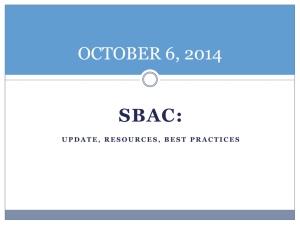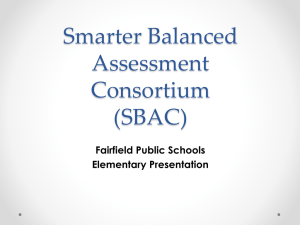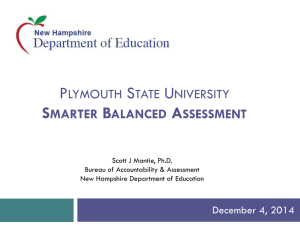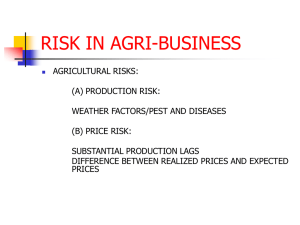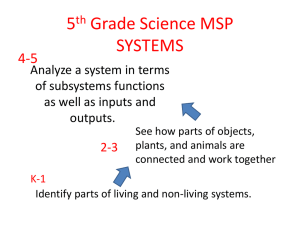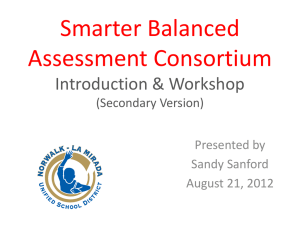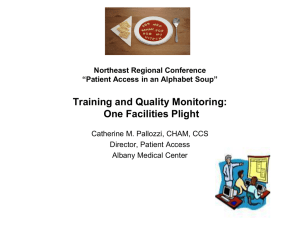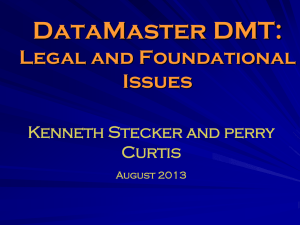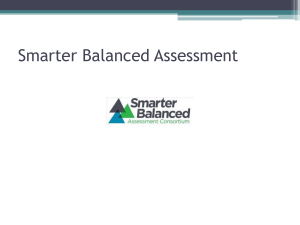OSPI Update - Educational Service District 113
advertisement
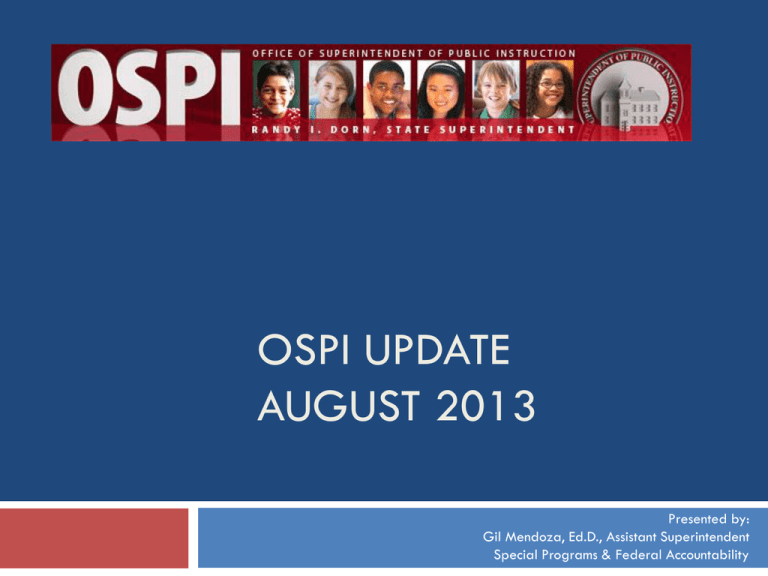
OSPI UPDATE AUGUST 2013 Presented by: Gil Mendoza, Ed.D., Assistant Superintendent Special Programs & Federal Accountability 2 2013 Legislative Session Summary K-12 Operating Budget General Apportionment Pupil Transportation 3 In SY 2013-14, the Legislature provided an additional $42.8 Million. STARS is fully funded in SY 2014-15 with an additional $88.8 Million. MSOC 4 Increases MSOC allocations as follows: Program General Education 2012-13 2013-14 Total Impact $554.57 $737.02 $171,224,761 Vocational $1,354.26 $1,399.30 $3,133,606 Skills Center $1,203.98 $1,244.25 $246,789 • Vocational and Skills Center MSOC allocations increased by inflation only. High Poverty Class Size Reduction 5 Grade Level 2012-13 Class Size 2013-14 Class Size Increase in Funding K-1 24.1 20.85 $45,337,896 2-3 24.1 24.1 $0 Districts will have to prove they are providing a class size of 20.85 for grades K-1 as condition of receipt of funds for the 2014-15 school year. OSPI must report draft rules to the Office of the Governor, and Legislative committees regarding monitoring K-1 class size by December 1, 2013. For 2014-15, an additional 2.222 hours of instruction per week is provided for Grades 7−12 (1080 hrs./year of instruction required). Transitional Bilingual 6 Continues to fund 4.778 additional hours of instruction per week for headcount of K-12 TBIP students. For the 2013-14 school year additional funding is provided in the form of an additional 3.0 hours per week for students who have exited the program during the prior school year. Increases funding by $6,130,530. For the 2014-15 school year the funding includes students who have exited the program during the prior two school years. 7 ESSB 5946 – Strengthening Student Educational Outcomes Omnibus policy bill Part I – Learning to Read Part II – Requiring the LAP program to be evidenced based Part III – Student Discipline Part IV – Educator Support Program Part V – Alternative Learning Experiences Part I – Learning to Read 8 Funds English Language Arts coordinators at ESDs. School districts are required to include K-4 reading information (student is reading at grade level) on report cards. Each school and each district must report the number of students in K-4 reading below grade level. Beginning in 2014-15, all 3rd grade students scoring a Level 1 (below basic) on MSP, student must receive intensive reading remediation. Beginning in 2015-16, this expands to students scoring a Level 1 or Level 2 on the MSP, and remediation strategies must be selected from a state menu. Beginning in 2015-16, for any school where more than 40% score at a Level 1 or Level 2 on the MSP, all students not reading at grade level in grades K-4 must receive remediation strategies selected from the state menu, paid for with LAP funds. Part II – Requiring the LAP program to be evidenced based 9 Adds reduction of disruptive behavior as a condition to serve. Requires OSPI to develop a state menu of approved LAP strategies, which are required to be used by districts beginning in the 2016-17 school year, unless otherwise state approved. Requires districts to prioritize the use of LAP funds to first serve grades K-4 reading. Up to 5% of the LAP allocation may be used for community/ESD partnerships (RTL) LAP plans are eliminated. Districts must report in CEDARS (2014-15) Annual entrance and exit performance data for each LAP student Districts must provide an annual report to OSPI (August 1, 2014 and each August thereafter) Amount of academic growth gained by students in LAP Number of students who gained at least one year of growth Specific LAP strategies used by each school Requires monitoring of LAP programs by OSPI every 4 years. Part III - Student Discipline Part IV – Educator Support Program 10 Part III – Student Discipline Discipline data reporting must be recorded in CEDARS. Discipline data categories is expanded, and disaggregation is required. Schools must create a reengagement plan. Emergency expulsions must be converted to long term suspensions or dropped after 10 days. Except in special circumstances, expulsions are limited to one year. Part IV – Educator Support Program Funds competitive grants for mentoring new teachers. Important Links 11 Legislative Budgets http://leap.leg.wa.gov/leap/default.asp Budget Driver (John Jenft) Rate Sheet http://www.k12.wa.us/SAFS/13budprp.asp Pivot Table http://www.k12.wa.us/SAFS/13budprp.asp Bus Depreciation https://eds.ospi.k12.wa.us/BusDepreciation/default.aspx 12 WA Learning Standards CCSS and NGSS Washington’s Implementation Timeline & Activities 13 2011-12 Phase 1: CCSS and NGSS Exploration Phase 2: Build Awareness & Begin Building Statewide Capacity Phase 3: Build Statewide Capacity and Classroom Transitions Phase 4: Statewide Application and Assessment Ongoing: Statewide Coordination and Collaboration to Support 2012-13 2013-14 2014-15 2015-16 2016-17 Washington’s CCSS Involvement & Process Summer 2009 to Present 14 DEVELOPMENT Draft K-12 English Language Arts and Mathematics Standards Released for State Input Summer 2009 WA INVOLVEMENT: Input on working drafts (CCSS Workgroup, 100+ educators) REVIEW/INPUT Public Review Revision Process Fall 2009 / Winter/Spring 2010 WA INVOLVEMENT: - Workgroup input - Statewide survey for input - Comments on Final Drafts ADOPTION States have discretion to voluntarily adopt CCSS Finalized June 2010 WA STATUS: - 2010 Provisional Adoption - Statewide Outreach & Input. - June 2011 Bias and Sensitivity Review - July 2011 Formal Adoption BUILD AWARENESS & CAPACITY State Collaboration and Sharing WA STATUS: - Phase-in support resources and structures starting in 2011-12 school year TRANSITION & APPLICATION • Aligned instructional materials and resources • Aligned Assessment Systems • Statewide assessment in 2014-15 We are here Washington’s NGSS Involvement & Process Summer 2011 to Present 15 DEVELOPMENT K-12 Framework for Science Education NGSS Drafting Process Confidential Drafts Summer 2011 WA INVOLVEMENT: - WA Selected as NGSS Lead State – Fall 2011 - Drafting Process – Fall 2011 – Spring 2012 - Statewide educator, stakeholder input REVIEW/INPUT Public Review Revision Process WA INVOLVEMENT: - Statewide educator, stakeholder input - Student input - National input - Comments on Final Drafts ADOPTION States have discretion to voluntarily adopt NGSS BUILD AWARENESS & CAPACITY TRANSITION & APPLICATION Final March 2013 State Collaboration and Sharing - Intentional transition plans - Alignment of instructional materials and resources - Assessment system adjustments WA STATUS: - Comparisons - Bias and Sensitivity - SBE Presentations Likely Adoption Summer 2013 We are here WA STATUS: Ongoing: Statewide Coordination and Collaboration to Support Implementation (CCSS/NGSS Professional Learning Providers and Partners Across WA) 16 Washington Including: • School Districts (CCSS District Implementation Network) • Higher Education • Education and Educator Content Associations • Business Partners Assessment System Updates Collection of Evidence Graduation Requirements Changes for 2013-14 SBAC SBAC assessments will measure career- and college-readiness 18 A Balanced Assessment System English Language Arts/Literacy and Mathematics, Grades 3-8 and High School School Year Last 12 weeks of the year* DIGITAL CLEARINGHOUSE of formative tools, processes and exemplars; released items and tasks; model curriculum units; educator training; professional development tools and resources; scorer training modules; and teacher collaboration tools. Optional Interim Assessment Computer Adaptive Assessment and Performance Tasks Optional Interim Assessment Computer Adaptive Assessment and Performance Tasks PERFORMANCE TASKS • ELA/Literacy • Mathematics Scope, sequence, number and timing of interim assessments locally determined COMPUTER ADAPTIVE TESTS • ELA/Literacy • Mathematics Re-take option *Time windows may be adjusted based on results from the research agenda and final implementation decisions. 19 Evolution to Smarter Balanced Summative Assessments in Washington 20 Reading Writing English/LA Math Math Science (end 20132014) (end 20132014) (begin 2014-2015) (end 20132014) (begin 20142015) (no change) SBAC MSP SBAC SBAC MSP SBAC Grade 3 MSP Grade 4 MSP Grade 5 MSP SBAC MSP SBAC Grade 6 MSP SBAC MSP SBAC Grade 7 MSP SBAC MSP SBAC Grade 8 MSP SBAC MSP SBAC High School MSP MSP See next slide MSP = Measurements of Student Progress HSPE = High School Proficiency Exams EOC = End of Course exams SBAC = Smarter Balanced Assessment Consortium See next slide MSP MSP Biology EOC With Summative High School Assessments in 2014–15 and beyond 21 English/LA Mathematics Science (no change) Grade 3 SBAC SBAC Grade 4 SBAC SBAC Grade 5 SBAC SBAC Grade 6 SBAC SBAC Grade 7 SBAC SBAC Grade 8 SBAC SBAC MSP Comprehensive ELA exit exam Year 1or Year 2 EOC exit exam EOC Biology exit exam (until NGSS) SBAC – College and Career Ready SBAC – College and Career Ready Grades10 (until Class of 2019) Grade 11 SBAC=SMARTER Balanced Assessment Consortium MSP= Measurements of Student Progress EOC= End of Course exams MSP Assessment High School Graduation Requirements by Class 22 English Language Arts Class of… Mathematics 2013 and 2014 Reading HSPE Writing HSPE Either Algebra or Geometry 2015 and beyond English Language Arts Either Algebra or Geometry Science Biology EOC (until NGSS) Class of… English Language Arts Mathematics Science 2015-2018 10th grade comprehensive ELA exit exam 11th grade college and career ready assessment Either Algebra or Geometry EOC exit exam Biology EOC 11th grade college and career ready assessment Biology EOC (Smarter Balanced ELA) (Smarter Balanced Math) 2019 and beyond (until NGSS) (until NGSS) What’s Happening This Year, 2013-14? 23 Exit exams remain the same (HSPE, EOC) CAA options remain the same Class of 2013 had some relaxation of Collection of Evidence rules that had been newly implemented – these will not continue (COE limited to one submission per content area throughout HS, and requires two attempts on general assessment before submitting) Schools will be recruited for Smarter Balanced field test Trying to avoid students having to take current test AND field test Should know by end of August how double testing can be avoided 23 ESEA Waiver 24 Good for 2013-14 2014-15 subject to: Possible legislation at state level Possible ESEA reauthorization at federal level Questions? 25 26 Thank you. Presented by: Gil Mendoza, Ed.D., Assistant Superintendent Special Programs & Federal Accountability Phone: (360) 725-6170 | E-mail: gil.mendoza@k12.wa.us

